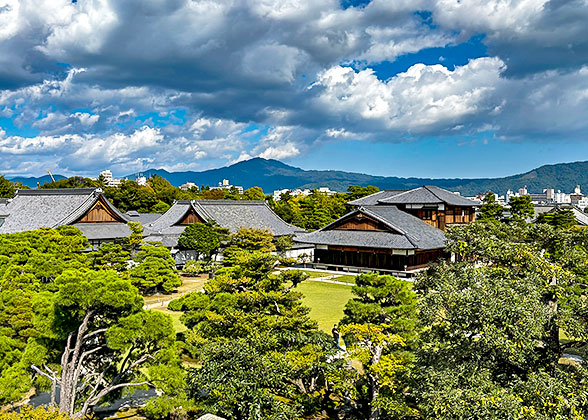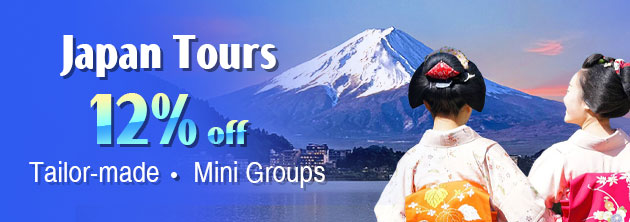Nagasaki Weather
What Is the Weather Like in Nagasaki?

Nagasaki after the Rain
|
Temperature
Although the yearly temperature difference is not as big as inland cities of Japan, it is obvious still. The average monthly maximum temperature ranges from 10-32°C (50-89.6℉) and the average monthly minimum temperature ranges from 4-26°C (39.2-78.8℉). If you decide to travel in Nagasaki, you need to make full preparations on your wearing based on the temperatures.
What is the hottest month in Nagasaki?
In Nagasaki, high temperatures are concentrated in August when the average high temperature is 32°C (89.6℉), but the historical highest temperature once reached 37°C (98.6℉). You may feel very uncomfortable and your skin may get burnt if you go out for too long in the middy without any protection.
What is the coldest month in Nagasaki?
January is the coldest month in Nagasaki, with the average lowest temperature of about 4°C (39℉). However, temperature in some parts of the region may drop below 0°C (32℉). Under such circumstance, the precipitation can occur in the form of snowfall and the roads can be icy and slippery. Thus, when going out, you need to wear enough warm clothes and anti-slippery shoes.
Precipitation
Rainfall in Nagasaki is relatively frequent. Even in October, the month with the least rainy days, the number of precipitation days can averagely reach more than 13. Early June to middle July in summer is Nagasaki’s rainy season. In June, the average precipitation can reach more than 450 mm, with a total of 19 rainy days. From July to September, heavy rain may be brought here by the landing of typhoon. The precipitation in spring and autumn is moderate, while that in winter is relatively low, including rainfalls and a few snowfalls. Driest Month: May: 114 mm / 12 precipitation days
Humidity
Humidity in Nagasaki throughout the year remains at a high level, part of the reason is that it is close to the sea. The highest levels occur in summer from June to August, reaching more than 80%. It should be noted that in the hottest month, August, the perceived temperature is even higher than the thermometer suggests as the humidity surges. You may feel very sticky in such hot and wet weather.
Best Time to Visit Nagasaki
The best time to visit Nagasaki is from late March to May in spring and September to November in autumn. During these two periods, the weather in Nagasaki is pleasant and mild, so you can enjoy outdoor activities comfortably. Apart from some well-known scenic spots, you can also admire some seasonal landscape. In spring, you can enjoy the cherry blossoms all over the fields. In autumn, you can immerse in the beautiful autumn leaves.Read more about Best Time to Visit Japan & Japan Weather
Seasons in Nagasaki - Climate and Travel Suggestions
Spring: March-May

Cherry Flowers in Spring
|
Spring is an ideal season for traveling in Nagasaki. Temperature starts to rise, but it is variable. In March, the average temperature is 7-16°C (44.6-60.8℉), so it is still a bit cold if you go outdoors in the morning or at dusk. By May, the weather is quite warm, with an average high temperature of 24°C (75.2℉); in sunny days, the high temperature can reach 28°C (82℉). Precipitation in spring mainly reflects on showers and it usually lasts for no more than three days in a row. But the temperature can drop prominantly by 4-7°C (39.2-44.6℉) because of the rain.
In March, the early spring, a shirt or sweater plus a thick coat is suitable. A long-sleeved shirt or a T-shirt with a thin coat or light jacket is recommended in April. In late spring in May, you can bring a summer T-shirt and a thin coat to get changed according to specific temperatures in a day. As for the bottom, a thick pants will do for early spring and a thin one for late spring.
Warm and sunny weather of Nagasaki in spring allows you to visit any place you are interested in, such as the Peace Park, the Atomic Bomb Hypocenter, Dejima, and Nagasaki Shinchi Chinatown. From late March to early April, there are beautiful cherry flowers in full bloom. You can enjoy them standing on the Meganebashi Bridge or walking around the Glover Garden and the Omura Park. But if you are allergic to pollen, it is recommended that you wear a mask.
Summer: June-August
Weather in summer is very hot, especially in August. The average high temperature during summer in Nagasaki is basically 27-32°C (80.6-89.6℉), while the average low temperature is 20-25°C (68-77℉). Besides, rainfall is heavy and frequent, especially during the rainy season from early June to the middle of July. The high rainfall, together with high temperature, makes people feel very sticky. Also, typhoon is more possible to occur in July and August.
Short-sleeve T-shirt and shorts are the most suitable clothing in whole summer, but it is necessary for you to take some sun protection measures, including applying sunscreen, wearing sun-protection clothing and wearing sunglasses. Skirt is also recommended for female tourists but not optimal in days with strong winds. Besides, it is highly recommended for you to take a parasol, which can protect you from the rain or being sun-burnt.
Traveling in summer in Nagasaki, you’d better get up early in order to avoid the strong mid-sunlight. You can walk around in the Peace Park in the morning or late afternoon, and have some food and take a rest in the restaurant nearby with air conditioning around hottest noon. You can also visit places like the Nagasaki Atomic Bomb Museum when it is hot or raining outside. At night, the temperature will cool down, you can go to Mount Inasa, taking in the twilight views of Nagasaki city.

Solemn Atomic Bomb Hypocenter
|
Autumn: September-November
Visiting Nagasaki in autumn is also a good choice, since the temperature gradually drops to a comfortable level. In September, the temperature averages at 22-29°C (71.6-84.2℉), so most of the time in this month is warm, even a little hot in mid-days. Notably, typhoon is even stronger but less frequent in September than in July and August. In mid-autumn and late autumn, the temperature will drop further, averaging at 13-25°C (55.4-77℉). If it rains in autumn, the temperature can suddenly drop by 5-7°C (41-44.6℉).

Beautiful Autumn Leaves in Nagasaki
|
Summer T-shirt and shorts are suitable for early autumn in September. Thin shirt and thin pants are recommended in October. However, it is always a wise idea to bring a thin coat with you in case the temperature drops at dusk. As for late autumn in November, you can wear a hoodie or a long-sleeved shirt with a wind-proof jacket. Umbrella is always necessary to be packed in your bag.
Autumn is suitable for all kinds of outdoor activities. You can walk around any attractions even wearing traditional Japanese clothing without feeling too hot. From October 7th to 9th, 2025, you can go to places like Jukai Shrine, Yasaka Shrine and Central Park where the annual grand autumn festival Nagasaki Kunchi is held. From late October to middle November, you can admire corlorful autumn leaves in Shindenan or the Central park.
Winter: December-February
Winter is the coldest season in Nagasaki. The high temperature averages at 10-12°C (50-53.6℉), and the low temperature averages at 4-6°C (39.2-42.8℉). In January, the coldest month, the temperature in some mountainous areas at night may drop below 0°C. Precipitation reflects mainly on the rainfalls, accompanied by a few snowfalls. There may be a total of 2-4 snowfalls in whole winter. The snow melts quickly as the temperature is not that low.
To prevent frostbite, it is necessary to wear a sweater plus a thick cotton-padded jacket or a windproof jacket. It is suggested that you wear thermal long johns plus thick pants for the bottom part. Choosing right shoes is also very important. Anti-slip snow boots are recommended as they are both warm and safe when you walk on the wet road. It is also useful to wear a scarf and an earmuff when you go outside.
The day is short in winter, so you’d better well arrange your itinerary and finish the day visiting places such as the Nagasaki Prefectural Art Museum and the Nagasaki Atomic Bomb Museum, both of which are near the Peace Park. After a few days of traveling, you may want to relax your body, so taking a hot spring bath in Mount Inasa is a good choice. It is worth mentioning that around Chinese New Year usually around middle January to middle February, Nagasaki Shinchi Chinatown will be decorated by many lanterns and celebrations like lion and dragon dances will be held.

Lion Dance in Chinese New Year in Nagasaki
|





